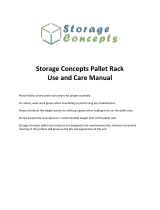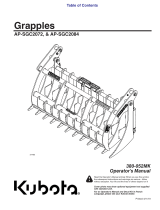
Section 3: Operating Procedures
Table of Contents
6/21/19AP-PFL4548, AP-PFL5548, & AP-PFL5560 Plate Mounted Pallet Forks 319-038MK
12
can cause the load to shift and fall onto the operator or
others. Rotating front of forks level or lower can cause the
load to fall forward.
• Optimize load stability and protect against load shifting.
Always adjust forks so that they are evenly spaced as far
apart as the load will allow and centered on the frame. Keep
load centered on the forks, even when stopped.
• Never lift a load with one fork or more than two forks.
Using one fork will cause the load to be unbalanced. Using
more than two forks will not increase the lift capacity and
can make the job unsafe.
• Always secure equipment with solid, non-concrete supports
before working under it. Never go under equipment
supported by concrete blocks or hydraulics. Concrete can
break, hydraulic lines can burst, and/or hydraulic controls
can be actuated even when power to hydraulics is off.
• Keep attachment, loader arms, and/or load away from
overhead electrical power lines. Place an orange warning
sign under overhead lines indicating type of danger above.
To avoid serious injury or death:
• Never carry riders on the attachment or power machine.
Riders can obstruct the operator’s view, interfere with
control of the equipment, be pinched by moving
components, become entangled in rotating components, be
struck by objects, be thrown or fall from the equipment, etc.
• Allow only persons to operate this implement who have
fully read and comprehended this manual, who have been
properly trained in the safe operation of this implement, and
who are age 16 or older. Serious injury or death can result
from the inability to read, understand, and follow
instructions provided in this manual.
• Backup alarm must be in good working order to warn
others. Use a backup camera or rear-view mirror that is in
good condition to help see undesirable situations behind the
unit. Drive at a slower speed to compensate for blind spots.
• Hydraulic fluid under high pressure can penetrate the skin
and/or eyes causing a serious injury. Wear protective gloves
and safety glasses or goggles when working with hydraulic
systems. Use a piece of cardboard or wood rather than
hands when searching for leaks. A doctor familiar with this
type of injury must treat the injury within a few hours or
gangrene may result. DO NOT DELAY.
• Check pallet fork frequently to make sure it is properly
attached to loader hitch, forks are secured to the upper and
lower carrying bars, and fork locking pins are seated in
their notches.
• Consult your power machine’s manual for operating
capacity, lifting capacity, and operating specifications.
Exceeding rated capacities and specifications can result in
a roll-over or other serious hazard.
• Do not abuse equipment. Incorrect use of the attachment
can damage equipment structurally and cause serious
injury or death.
Section 3: Operating Procedures
Operating Checklist
Hazard control and accident prevention are dependent
upon the awareness, concern, prudence, and proper
training involved in the operation, transport, storage, and
maintenance of the pallet fork. Therefore, it is absolutely
essential that no one operates this unit unless they are
age 16 or older and have read, fully understood, and are
totally familiar with the Operator’s Manual. Make sure the
operator has paid particular attention to:
Perform the following inspections before using your
Pallet Forks.
Operating Safety
To avoid serious injury or death:
• A crushing hazard always exists around equipment
handling palletized loads. Objects on pallet can shift and
fall resulting in death or serious injury.
• Keep bystanders, pets, and livestock away from your work
area. Never allow anyone to go near or under the
attachment or its load. The attachment and/or load can fall.
• Do not drive up to anyone or an animal in front of a fixed
object such as a wall or bench. Never assume that the power
machine will stop in time.
• Use a “spotter” when it is hard to see in the direction you
are traveling and when placing a load that obstructs your
vision. A person or animal could be nearby in a blind spot.
• Never lift objects without pallets and make sure all objects
are secured before lifting them. Use extreme care when
securing round objects to make sure they can’t roll off.
• Lift only objects that have a stable base resting on the
pallet. Uneven, irregular, or round bases can easily tip off
or roll off the pallet.
• Do not lift a load that exceeds the attachment’s load guard
height, or has objects smaller than the openings in the load
guard.
• Keep load slightly tilted back to secure its weight against
the vertical face of the forks. Rotating front of forks too high
Operating Checklist
Check Page
Read and follow all safety rules carefully.
Refer to “Important Safety Information” and
Safety Alert Symbols throughout this manual.
1
Read and follow assembly & hook-up
instructions.
Refer to “Section 1: Assembly & Set-Up”.
9
Read and follow all operating procedures.
Refer to “Section 3: Operating Procedures”.
12
Read and follow all maintenance Instructions.
Refer to “Section 4: Maintenance & Lubrication”.
16
Make sure there are no hydraulic leaks.
Refer to “Avoid High Pressure Fluids Hazard”.
3
Check pallet fork initially and periodically for
loose forks, hitch plate, bolts, and pins. Refer to
“Torque Values Chart for Common Bolt Sizes”.
21

























